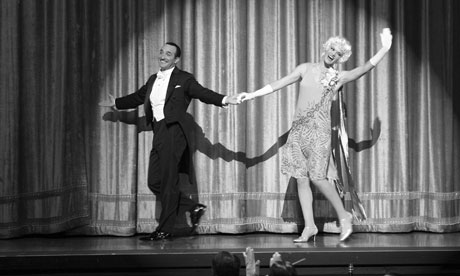
Sing it loud: a silent film has carried home the best picture Oscar for the first time since the very first Academy Awards ceremony was held in 1929. And don't let anyone tell you that because The Artist is silent and black-and-white it is merely a throwback – its triumph is a cause for celebration and a very real sign of progress.
To see how far we've come since the coming of sound, you need only look at the troubled history of that first outstanding production winner, Wings. "Wild Bill" Wellman's first world war movie is exactly the kind of film we now expect to scoop armfuls of Oscars. It's an effects-heavy blockbuster, thick with patriotism and sentiment. Those breathtaking aerial combat shots still look stunning, as does its vivacious star Clara Bow.
Wings ran for years, raked in millions of dollars, won a couple of Academy Awards, and then, like The Artist's George Valentin, it vanished. Because it was a silent film, because it was an old film, apparently no one took the time to take care for the reels that had been in circulation and for decades Wings was officially considered lost. It wasn't until the 1960s that some kind soul discovered a fragile nitrate print and made a copy. Wings was back in action, but in a fairly dilapidated, cut-down state. Finally, this year, a full restoration was completed and released on Blu-ray. Who would have guessed that we wouldn't be able to see Wings again until the next time a silent film won best picture?
Reading on mobile? Watch a trailer for Wings here
Film preservation doesn't happen by itself; it takes care and technology and a good deal of money. Which is a lesson we've learned slowly, over the near 120-year history of the cinema. So, as a rule, studios no longer toss their movies aside the moment they leave the cinemas. There are national and local archives, and with home video, we're all the keepers of our own private collections. By contrast, in Michel Hazanavicius's silent film, Valentin burns his own work because he feels it is outdated, just as in that other Oscars big-hitter Hugo, George Méliès's precious trick movies are melted down and made into shoes.
Valentin is a fiction, but Méliès is not, and the dangerous combination of bonfires and neglect means that around 80% of the films made in the silent years have been lost. It has become a commonplace to say that silent movies were old hat once the talkies came in, but the reality of that switch was brutal and it should be as abhorrent to us to burn films as it is to burn books.
The industry is going through another upheaval at the moment: the shift from celluloid to digital film-making and projection. Imagine the horror if, in this transition, the old "analogue" archives were treated as shabbily as the silents were.
The Artist is a testament to the achievements of a past era – achievements that are all the more worth celebrating because so many of them were nearly lost for ever. Its embrace by the Academy is, hopefully, proof that we won't turn our back on our past again.

